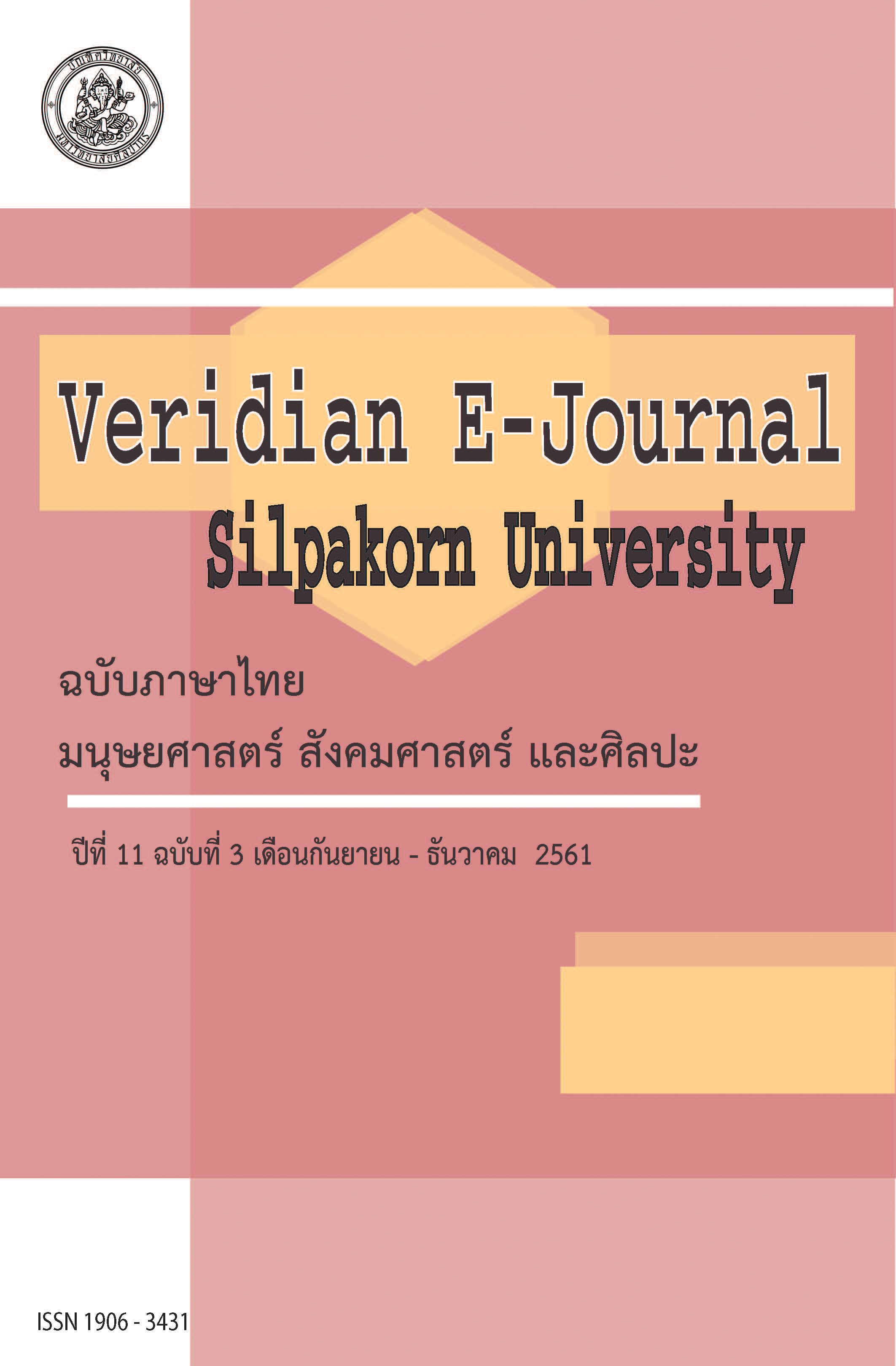การวิเคราะห์ผลงานการประพันธ์เพลงเถาของ ครูอุทัย แก้วละเอียด ศิลปินแห่งชาติ สาขาศิลปะการแสดง (ดนตรีไทย) ปีพุทธศักราช 2552 (An Analysis of “Plang Tao Song” Composed by Uthai Kaewla-iad, a Thai National Artist in Performing Arts (Thai Classical Music) in B.E.2552)
Main Article Content
Abstract
การศึกษาบทเพลงของครูอุทัย แก้วละเอียด มีวัตถุประสงค์เพื่อศึกษาการรับการถ่ายทอดด้านหลักการประพันธ์ วิเคราะห์ผลงานการประพันธ์เพลงเถา และสังเคราะห์แนวทางการประพันธ์เพลงเถา ใช้ระเบียบวิธีการวิจัยเชิงคุณภาพ เก็บข้อมูลจากบทเพลงเถาจำนวน 4 เพลง โดยการวิเคราะห์จากทำนองหลัก และยืนยันข้อมูลด้วยการสัมภาษณ์ครูอุทัย แก้วละเอียด ลูกศิษย์ครูอุทัย แก้วละเอียด และผู้เชี่ยวชาญทางดนตรี จำนวน 10 ท่าน ผลการวิจัยพบว่า (1)หลักการประพันธ์เพลงของครูอุทัย ใช้หลักการสร้างสรรค์เพลงใหม่ และการนำเพลงเก่ามาเสนอรูปแบบหรือวิธีการใหม่ โดยใช้สังคีตลักษณ์ คือ เน้นเพลงที่สามารถใช้ได้หลากหลายโอกาส และวงดนตรี บันไดเสียง : ใช้บันไดเสียง 5,6,7 เสียง หน้าทับ : หน้าทับสองไม้เพื่อจะใช้ได้กว้างขวางขึ้น การเคลื่อนทำนอง : ต้องประพันธ์ให้มีลูกตกทำนองที่กลมกล่อมทั้งกำหนดท่วงทีลีลา อารมณ์เพลงที่ชัดเจน กลวิธีบรรเลง : เน้นการสร้างทำนองที่แสดงฝีมือนักดนตรี (2)การวิเคราะห์ผลงานการประพันธ์เพลงเถา พบว่า มีบทเพลงท่อนเดียว บทเพลงท่อนเดียว ได้แก่ เพลงเทพทอง เถา พร้อมด้วยเที่ยวเปลี่ยน ทุกอัตราจังหวะ ทั้งมีการซ้ำสำนวนประโยคระหว่างท่อนปกติกับเที่ยวเปลี่ยนในประโยคสุดท้ายของท่อน บทเพลงสองท่อน ได้แก่ เพลงอุศเรน เถา มีการประพันธ์เที่ยวเปลี่ยนในอัตราจังหวะสามชั้น และมีการซ้ำท้ายระหว่างท่อน รวมทั้งเพิ่มเพลงลูกบท เพลงดอกไม้เหนือ เถา มีกลุ่มทำนองเป็นเอกเทศ ไม่มีการซ้ำหัวหรือท้าย เพลงเทพนฤมิต เถา มีลักษณะบังคับทางสำนวนกรอ สำนวนลูกล้อลูกขัด เหลื่อม และมีแบบแผนด้วยการซ้ำทำนองช่วงสองจังหวะสุดท้ายของท่อน นอกจากนี้ยังพบสำเนียงภาษาสอดแทรกในบทเพลง คือ เพลงอุศเรน เถา เพลงเทพนฤมิต เถา โดยทุกเพลงใช้จังหวะหน้าทับสองไม้ในการประพันธ์เป็นหลัก (3)การสังเคราะห์แนวทางการประพันธ์เพลงเถา พบว่า ครูอุทัย แก้วละเอียด ประพันธ์เพลงจากความทรงจำเป็นแรงบันดาลใจโดยใช้การสร้างสรรค์ดังนี้ (3.1) การสร้างทำนองเกริ่น (3.2) การใช้บันไดเสียงที่หลากหลายในบทเพลง (3.3) การประพันธ์เที่ยวกลับหรือเที่ยวเปลี่ยนในบทเพลง (3.4) การเดี่ยวและการสร้างเพลงลูกบทท้ายบทเพลงเถา โดยหลักการทั้งสามยึดถือการใช้บันไดเสียง และลูกตกเสียง ตลอดจนท่วงทีลีลาของบทเพลงตามวัตถุประสงค์ของบทเพลง เพื่อให้นักดนตรีแสดงความสามารถทั้งในการบรรเลงรวมวง และการบรรเลงเดี่ยว
This study of Kru Uthai Kaewla-iad’s songs aimed to acknowledge, analyze, and pass on the musical composition’s techniques of Plang Tao and to synthesize Plang Tao’s arrangement techniques. The data is collected from four Plang Tao songs by analyzing from main melody and is verified by interviewing Kru Uthai Kaewla-iad detailing students Kru Uthai Kaewla-iad and ten music experts. The research results pointed out that (1) the techniques of musical composition of Kru Uthai Kaewla-iad were to employ new composition and revise old songs by means of musical forms; that is, she selected songs played in various occasions and by various musical bands. The scale 5, 6 and 7 were used. Song Mai pattern was also used for extending the melodies. According to the rhythmical succession of melody, it is necessary to have a delicate Look Tok melody to set the music’s style and emotion outstandingly. Additionally, music performance, the production of special melodies to present the musician’s expertise was considered as important. (2) An analysis of musical composition found 4 types of the melodies. First, a solo melody was found, Plang Dhepthong Tao, with structural differences in melodies at the second movement at every meter and a verse repetition between a regular movement and the next movement coming with structural differences in melodies from the former movement at the last verse of the movement. Second, a duple meter melody, Plang
U-saren Tao, was composed by structural differences in melodies; the second movement started at triple meter and there was repetition at the end of each verse and the augmentation of Plang Look Bot. Third, Plang Dok Mai Nuea Tao had unique groups of melodies without repetition at the beginning and the end of verses. Fourth, Plang Dhep Narue Mit Thao had an exact verse feature in Kraw melody, Look Lor Look Khut melody, and overlapping and methodical repetition at the last two rhythms of movement. Besides, there were a lyrius in the music such as Plang U-saren Tao and Plang Dhep Nimit Tao. Mainly, every song had Song Mai pattern. (3) The synthesis of Plang Tao’s arrangement techniques showed that Kru Uthai Kaewla-iad composed songs with her commemoration inspirationally and creatively; that is, (3.1) The composition of introduction melody (3.2) Various scale used in music (3.3) A composition with structural differences in melodies at the next movement (3.4) A solo and Plang Look Bot’s composition at the end of Plang Tao. All of the three principles adhered to musical pitch and Look Tok note as well as the music’s style, in terms of the music’s objectives, in order to give musicians opportunities to show their talent with the musical ensemble and as a soloist without an accompany.
